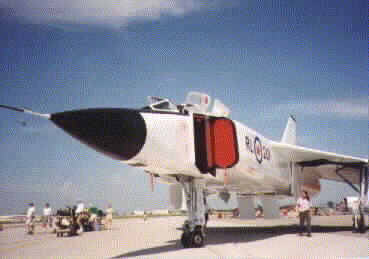alwaysfresh
New Member
All this BS about copying technology with China. I wanted to say everyone in the world does it and the best example is above the Avro CF-105 Arrow from Canada. It was cancelled for its success. All that technology was a big lost for the Canadian economy.




"In April 1953, after a year of analysis by Avro, the Royal Canadian Air Force (RCAF) presented a requirement for a twin-engined, two-seat interceptor with a maximum speed of Mach 2, a maximum ceiling of 18.3 kilometers (60,000 feet), and a combat radius of 370 kilometers (200 nautical miles).
...
On 20 February 1959, Prime Minister Diefenbaker cancelled the CF-105, with the order taking effect immediately. The prototype Arrows had completed 66 flights, for a total of 70 hours of flying time. The first Mark 2 prototype was almost ready for flight tests, with four more Mark 2s virtually complete. All the Arrows built or in production were scrapped, and design documentation and production tooling was generally disposed of. None of the Iroquois-powered Mark 2s ever flew.
...
Avro ended up laying off 14,000 workers. The layoffs were a massive shock to Canada's aircraft industry, and the day of the Arrow's cancellation has been known as "Black Friday" ever since. Air Marshall Campbell obtained 66 F-101 Voodoo supersonic interceptors from the United States to handle his air-defense requirements. The Voodoo was a perfectly modern aircraft for the time, capable of Mach 2 flight; it wasn't an Arrow by any means, but it was available.
...
Interestingly, while the Canadians were working on the Arrow, the Americans were working on a conceptually similar long-range, high-performance interceptor, the North American "F-108 Rapier". The Rapier never got beyond the mockup stage, being cancelled in September 1959. The same logic that worked against the Arrow worked against the Rapier, with the same results. Whatever the facts of the case, it is hard not to sympathize with those who dream of the CF-105 thundering on patrol over Canada's snow-covered north.




"In April 1953, after a year of analysis by Avro, the Royal Canadian Air Force (RCAF) presented a requirement for a twin-engined, two-seat interceptor with a maximum speed of Mach 2, a maximum ceiling of 18.3 kilometers (60,000 feet), and a combat radius of 370 kilometers (200 nautical miles).
...
On 20 February 1959, Prime Minister Diefenbaker cancelled the CF-105, with the order taking effect immediately. The prototype Arrows had completed 66 flights, for a total of 70 hours of flying time. The first Mark 2 prototype was almost ready for flight tests, with four more Mark 2s virtually complete. All the Arrows built or in production were scrapped, and design documentation and production tooling was generally disposed of. None of the Iroquois-powered Mark 2s ever flew.
...
Avro ended up laying off 14,000 workers. The layoffs were a massive shock to Canada's aircraft industry, and the day of the Arrow's cancellation has been known as "Black Friday" ever since. Air Marshall Campbell obtained 66 F-101 Voodoo supersonic interceptors from the United States to handle his air-defense requirements. The Voodoo was a perfectly modern aircraft for the time, capable of Mach 2 flight; it wasn't an Arrow by any means, but it was available.
...
Interestingly, while the Canadians were working on the Arrow, the Americans were working on a conceptually similar long-range, high-performance interceptor, the North American "F-108 Rapier". The Rapier never got beyond the mockup stage, being cancelled in September 1959. The same logic that worked against the Arrow worked against the Rapier, with the same results. Whatever the facts of the case, it is hard not to sympathize with those who dream of the CF-105 thundering on patrol over Canada's snow-covered north.
Last edited:
